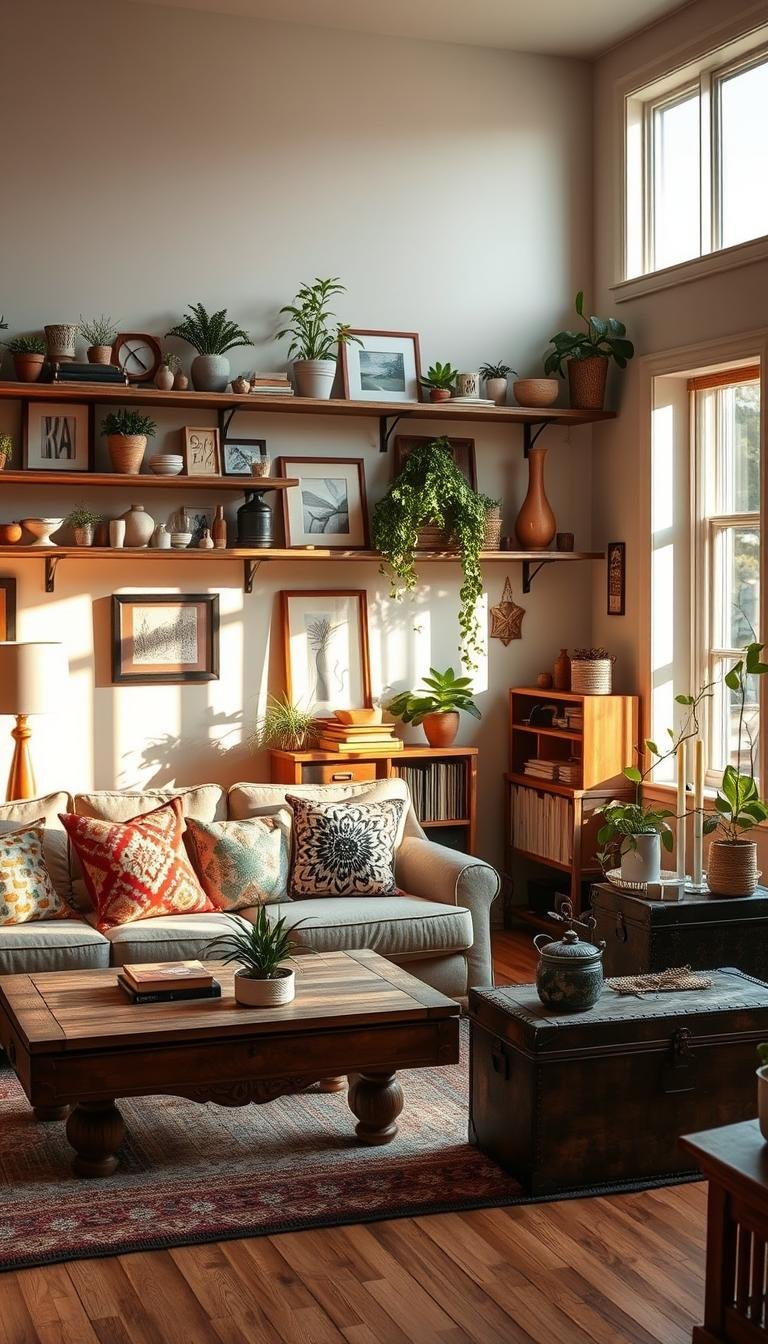Organic Dream Home Design: Crafting Your Sustainable Oasis
Can a sustainable living space be a haven for you and the environment? Imagine waking up to leaves rustling and natural light through big windows. It brings in amazing outdoor views.
Making an eco-friendly home is more than a trend. It’s a choice that connects you with nature. Adding lush greenery and bright flowers to your home design creates a peaceful oasis. It’s good for you and the planet.
Starting this journey, you’ll see how to mix indoor and outdoor spaces. This creates a perfect balance that changes what a dream home means.
Key Takeaways
- Understand the principles of sustainable living spaces
- Learn how to incorporate natural elements into your home
- Discover eco-friendly materials for your dream home
- Explore the benefits of connecting indoors with outdoors
- Find inspiration for crafting your unique sustainable oasis
The Philosophy Behind Sustainable Living
Living sustainably means making your home and nature friends. It’s not just about being green. It’s about loving nature and living in a way that’s good for the planet.
Connecting with Nature Through Architecture
Your home’s design can help you feel close to nature. Big windows, natural stuff, and green areas make your home feel like it’s part of the outdoors. This makes you feel better and helps you love the earth more.
Balancing Aesthetics and Environmental Responsibility
It’s hard to make your home look good and be green at the same time. But it’s possible. Use eco-friendly stuff, save energy, and add natural touches. This way, your home will be both pretty and good for the planet.
Frank Lloyd Wright said,
‘Study nature, love nature, stay close to nature. It will never fail you.’
This shows what sustainable living is all about. It’s about loving nature in your home design.
By living sustainably, you can make a home that’s beautiful and helps the planet. It’s a win-win for you and the earth.
Fundamental Principles of Organic Dream Home Design
Starting an organic dream home means loving the earth and making your home beautiful. It’s about mixing your home with nature in a good way.
Harmony with Natural Surroundings
It’s important to make your home fit with its surroundings. Think about the land, weather, and plants around it. This way, your home will be a part of nature and make it better.

Sustainable Materials and Resources
Choosing the right materials is key. Sustainable materials like old wood, bamboo, and special paints are good for the earth. They also make your home special. Using local materials helps the planet too.
| Material | Sustainability Benefits |
|---|---|
| Reclaimed Wood | Reduces waste, preserves history |
| Bamboo | Fast-growing, highly renewable |
| Low-VOC Paints | Improves indoor air quality |
Energy Efficiency and Renewable Solutions
Making your home energy-smart is important. Use solar and wind power, and choose smart appliances. This cuts down on bad energy use and helps the planet.
“The best way to predict the future is to invent it.” – Alan Kay
Following these ideas, you can build a home that’s lovely, useful, and kind to the earth.
Selecting the Perfect Location for Your Eco-Friendly Haven
Finding the right spot for your eco-friendly home is the first step. This choice affects how your home looks and its impact on the planet.
Maximizing Natural Light and Panoramic Views
Think about where to put your home to get lots of natural light. The right spot can cut down on the need for lights that use energy. Also, a spot with panoramic views lets you feel closer to nature.

Considering Local Ecosystems and Biodiversity
Look at the local plants and animals around your future home. This helps make sure your home doesn’t harm the natural world. You might need to work around plants or add native ones to your yard.
Climate-Responsive Positioning for Energy Efficiency
How your home faces the sun can save a lot of energy. For example, in hot places, facing away from the sun can lower cooling costs. Here’s a table with tips for different climates:
| Climate | Positioning Strategy | Energy Efficiency Benefit |
|---|---|---|
| Warm | Shade-oriented design | Reduced cooling costs |
| Cold | South-facing orientation | Increased passive heating |
| Temperate | Balanced orientation | Optimal natural lighting and heating/cooling |
Choosing the right spot for your eco-friendly home is key. Think about natural light, local plants and animals, and how your home will face the sun. This way, you can make a home that’s good for the planet and looks great too.
Sustainable Building Materials for Your Organic Home
Building an eco-friendly home begins with the right sustainable building materials. These materials affect the environment and your family’s health.
Using reclaimed and recycled materials helps reduce waste. Reclaimed wood adds charm and keeps history alive. Recycled glass countertops are a green choice instead of regular materials.
Reclaimed and Recycled Options
Some top choices include:
- Reclaimed wood for floors and walls
- Recycled glass countertops
- Recycled metal roofing
Natural and Non-Toxic Materials
It’s key to pick natural and non-toxic materials for a healthy home. Natural clay, lime plaster, and safe paints keep your home chemical-free.
Locally-Sourced Resources to Reduce Carbon Footprint
Choosing locally-sourced resources helps the local economy and cuts down on carbon emissions. Local materials fit well with the local climate and environment.
Using these materials makes your home eco-friendly and healthy. The image below shows how sustainable materials can look good and work well.

Choosing sustainable materials is a big step towards a green home. It shows you care about your values and the planet.
Bringing the Outdoors In: Interior Greenery Strategies
Bringing the outdoors in is more than a trend. It’s about mixing nature with your home. This makes your home look better and healthier.
Strategic Window Placement for Breathtaking Outdoor Views
One easy way to bring the outdoors in is with strategic window placement. Plan your windows well to get amazing views and lots of natural light. This cuts down on the need for artificial lights and connects you to nature.

Indoor Gardens and Living Walls
Indoor gardens and living walls bring the outdoors inside. These eco-friendly features clean the air and make your home look natural. Pick plants that do well indoors to keep your home green and lively.
Incorporating Seasonal Flowers Throughout Your Home
Adding seasonal flowers to your home keeps it fresh and lively. Flowers bring color, smell, and a connection to the seasons. Choosing local flowers helps farmers and is good for the planet.
Using these strategies, you can make your home feel like the outdoors. Whether it’s windows, gardens, or flowers, it makes your home better and healthier.
Creating an Organic Kitchen: The Heart of Sustainable Living
Having an organic kitchen makes cooking better and helps the planet. It’s a great place to start living green. Your kitchen can be both useful and good for the earth.
Eco-Friendly Appliances and Fixtures
Choosing eco-friendly appliances is key for an organic kitchen. They use less energy and harm the planet less. Look for the ENERGY STAR label to know they’re efficient.

Sustainable Countertops and Cabinetry
Picking sustainable countertops and cabinets is important too. Use materials like reclaimed wood, bamboo, or recycled glass. They’re good for the earth and make your kitchen look cool. For cabinets, go for wood from local places or FSC-certified timber.
Indoor Herb Gardens and Functional Greenery
Adding indoor herb gardens makes your kitchen feel organic. They clean the air and give you fresh herbs. Use self-watering planters or a living wall to save space.
| Material | Sustainability Benefits | Aesthetic Appeal |
|---|---|---|
| Reclaimed Wood | Reduces waste, conserves resources | Unique, rustic charm |
| Bamboo | Fast-growing, renewable resource | Modern, sleek appearance |
| Recycled Glass | Reduces landfill waste, conserves raw materials | Contemporary, elegant look |
With these choices, your kitchen becomes more than just a place to cook. It’s a symbol of living green.
Tranquil Organic Bedroom Designs for Restful Sleep
Creating a calm bedroom is key for a good night’s sleep. Your bedroom should be a cozy, relaxing, and green space.

Natural Bedding and Furniture Materials
It’s important to pick the right materials for your bed and furniture. Choose natural fibers like cotton, linen, or bamboo for your bedding. They are soft and let air through.
For furniture, go for reclaimed wood or sustainably sourced materials. This helps the planet.
Air-Purifying Plants and Floral Elements
Adding air-purifying plants like lavender or snake plants is a great idea. They make the air cleaner. Plus, they help you sleep better.
Adding floral elements or a vase with fresh flowers also makes your room feel calm.
Non-Toxic Paint and Finishes for Healthier Air Quality
It’s important to use non-toxic paint and finishes for clean air. Look for paints that say low-VOC (Volatile Organic Compound) or zero-VOC. This keeps the air in your home clean.
By adding these touches, you can make a peaceful and green bedroom. It will help you sleep better and live healthier.
Eco-Conscious Bathroom Design: Water Conservation and Natural Elements
A sustainable bathroom is more than saving water. It’s about making a space that’s relaxing and good for the planet. You can enjoy a luxurious bath while helping the environment.

Water-Saving Fixtures and Greywater Systems
To make your bathroom eco-friendly, use water-saving fixtures. Choose low-flow showerheads, toilets, and faucets. They cut down water use a lot.
Also, think about getting a greywater system. It uses water from sinks and showers for plants and toilets.
Sustainable Vanities and Countertops
It’s important to pick sustainable vanities and countertops. Go for reclaimed wood, bamboo, or recycled glass. They save resources and make your bathroom special.
Make sure the finishes and adhesives are safe for the planet.
Humidity-Loving Plants That Thrive in Bathroom Environments
Bathrooms are great for plants that love moisture. Add plants like ferns, orchids, or peace lilies. They make your bathroom look good and clean the air.
By adding these green touches, your bathroom becomes both fancy and green. Every little change helps. Making your bathroom eco-friendly is a step towards a greener life.
Designing Your Outdoor Organic Oasis
Creating an outdoor organic oasis means bringing nature to your home. It’s more than just planting trees or flowers. It’s about making a space that’s beautiful, functional, and good for the planet.
Native Landscaping Principles for Sustainable Beauty
Native landscaping is key to organic design. It uses plants that grow well in your area. This helps local animals and saves water and work.

Creating Flower Gardens That Support Local Pollinators
Flower gardens are pretty and help bees and butterflies. Pick flowers that bloom at different times. This makes a garden that pollinators love all year.
| Flower Type | Bloom Period | Pollinator Attraction |
|---|---|---|
| Lavender | Summer | High |
| Sunflowers | Summer | High |
| Dahlias | Fall | Medium |
Edible Gardens and Food Forests
Edible gardens and food forests make your space useful. You can grow your own food and save the planet. Try a food forest with many plants that help each other.
Sustainable Outdoor Living Spaces
Sustainable outdoor spaces are good for the planet. Use recycled furniture and energy-saving lights. Make spaces that encourage being outside without harming the environment.
By adding these features, you can make a beautiful, green space. It can help pollinators, grow food, or just be a nice place to be. There are many ways to make your outdoor area special.
Maintaining Your Organic Dream Home Throughout the Seasons
To keep your organic home thriving, adapt your maintenance to the seasons. This makes sure your eco-friendly space stays beautiful all year.

Seasonal Plant Care and Rotation
Seasonal plant care is key for your home’s health and beauty. Rotate plants to get the right light and temperature. In winter, move plants needing less light to shady spots. In summer, put them in sunnier places to avoid burning.
Natural Cleaning Solutions for Eco-Friendly Maintenance
Using natural cleaners is important for your organic home. Choose eco-friendly products or make your own with items like baking soda, vinegar, and lemon juice. These are good for the planet and your health.
Sustainable Pest Management Strategies
Managing pests is vital for your organic home. Avoid chemical pesticides. Instead, use beneficial insects, natural repellents, and keep things clean to stop pests.
Adapting Your Space to Seasonal Changes
Changing your space with the seasons makes your home more comfortable and green. In winter, use thick curtains to keep warm. In summer, open windows for cool air. Seasonal decor changes also help your home’s energy and feel.
Conclusion: Embracing the Organic Lifestyle in Your Dream Home
Creating an organic dream home is more than looks. It’s about living in a way that’s good for the planet and you. By following the tips in this article, you can make a home that’s both beautiful and eco-friendly.
Your dream home can be a place of beauty and health. It’s where every part, from the building materials to the plants, helps the planet. Living an organic lifestyle means choosing wisely in your daily life.
Using green materials, letting in lots of sunlight, and adding plants makes your home special. It’s not just a place to live; it’s a space that cares for you and the earth. Every choice you make can help the planet, making your home a green oasis.






